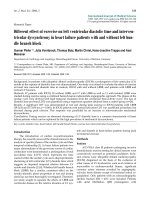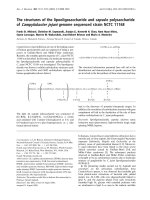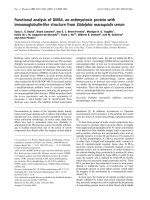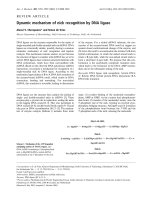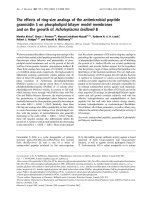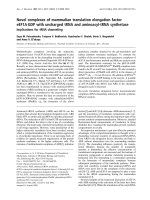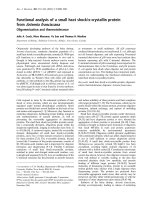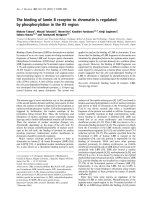Báo cáo Y học: Tag-mediated isolation of yeast mitochondrial ribosome and mass spectrometric identification of its new components ppt
Bạn đang xem bản rút gọn của tài liệu. Xem và tải ngay bản đầy đủ của tài liệu tại đây (494.6 KB, 12 trang )
Tag-mediated isolation of yeast mitochondrial ribosome and mass
spectrometric identification of its new components
Xiang Gan
1
, Madoka Kitakawa
2
, Ken-ichi Yoshino
3
, Noriko Oshiro
3
, Kazuyoshi Yonezawa
3
and Katsumi Isono
1,2
1
Graduate School of Science and Technology,
2
Department of Biology, Faculty of Science, and
3
Biosignal Research Center,
Kobe University, Japan
Mitochondrial ribosomal proteins (mrps) of the budding
yeast, Saccharomyces cerevisiae, have been extensively
characterized genetically and biochemically. However, the
list of the genes encoding individual mrps is still not complete
and quite a few of the mrps are only predicted from their
similarity to bacterial ribosomal proteins. We have con-
structed a yeast strain in which one of the small subunit
proteins, termed Mrp4, was tagged with S-peptide and used
for affinity purification of mitochondrial ribosome. Mass
spectrometric analysis of the isolated proteins detected most
of the small subunit mrps which were previously identified
or predicted and about half of the large subunit mrps. In
addition, several proteins of unknown function were iden-
tified. To confirm their identity further, we added tags to
these proteins and analyzed their localization in subcellular
fractions. Thus, we have newly established Ymr158w
(MrpS8), Ypl013c (MrpS16), Ymr188c (MrpS17) and
Ygr165w (MrpS35) as small subunit mrps and Img1, Img2,
Ydr116c (MrpL1), Ynl177c (MrpL22), Ynr022c (MrpL50)
and Ypr100w (MrpL51) as large subunit mrps.
Keywords: mitochondrial ribosomal proteins; Saccharomy-
ces cerevisiae; tag-assisted purification; mass-spectrometry.
The mitochondrial genome codes for only a small number
of proteins that are translated on the mitochondrial
ribosome (mitoribosome). Previous studies showed that
the mitoribosome contains more proteins than its bacterial
counterpart [1–5]. This may indicate that some of the
mitochondrial ribosomal proteins (mrps) have been recrui-
ted to compensate the reduced size of the mitoribosomal
RNAs. It is likely at the same time that some of them might
carry some hitherto unknown mitochondrial functions. It
should be noted in this regard that the mitochondrial
genome-encoded components of the yeast respiratory chain
require specific translational activators [6] and some of them
interact with the mitoribosome [7–10]. A large subunit
protein, Rml2, was found to be involved in the utilization of
oleate as a carbon source [11] and its mutation affected the
activity of transcription factor Adr1 [12]. One of the small
subunit proteins of yeast mitoribosome, YmS2 (Ppe1), has
similarity to human protein phosphatase-methylesterase.
Another small subunit protein Rsm23 is a member of the
DAP3 family of mitochondrial apoptosis mediators [13].
Two large subunit proteins, MrpL31 and Ygl068w the latter
of which is probably related to Escherichia coli L7/L12
proteins, might be involved in cell cycle control [14].
Furthermore, MrpS18, Rsm10, and YmL6 proteins are
not only essential for the function of mitochondria but also
indispensable for cellular growth [15]. From these results it is
conceivable that some mrps play a role in communication
between mitochondria and other subcellular organelles
including the nucleus and peroxisome.
Recent studies on the mammalian mitoribosomes showed
that they also contain many proteins [16–19], despite the
highly reduced size of their genomes. Interestingly, many of
the proteins that do not resemble bacterial ribosomes
appear to be unique in each organism. In order to
investigate the functions of mitoribosome that are distinct
from bacterial or cytoplasmic ribosomes, and to gain
further insight into the evolution of mitochondrial transla-
tion system, we have attempted to identify as many mrps
and associated proteins as possible. For this purpose, we
used mass spectrometry and identified several new yeast
mrps as described below.
MATERIALS AND METHODS
Plasmid construction
pSHLeu plasmid (Fig. 1) was used to produce S-tagged
mrps in yeast. It was based on the pDBLeu vector
(GibcoBRL, Life Technologies) and constructed by insert-
inga140-bpMscI–NcoI fragment of plasmid pET-32a(+)
(Novagen) encoding S-tag peptide into the MscI–NcoIsite
of pDBLeu. Subsequently, the HindIII–SmaIfragment
containing the GAL4 DNA binding domain was replaced
with the HindIII–SmaI fragment containing the multiclon-
ing site of pUC119 plasmid.
All plasmids containing the S-tagged mrp genes were
constructed using pSHLeu. DNA fragments harboring
respective genes without termination codon were amplified
by PCR from the genomic DNA of RAY3A-D cells by
Correspondence to M. Kitakawa, Department of Biology,
Faculty of Science, Kobe University, Rokkodai, Nada,
Kobe, Japan 657–8501. Fax: + 81 78 803-5716,
E-mail:
Abbreviations: mitoribosome, mitochondrial ribosome; mrp,
mitochondrial ribosomal protein; AP, alkaline phosphatase.
Enzyme: lysyl endopeptidase (EC 3.4.21.50).
(Received 4 July 2002, revised 30 August 2002,
accepted 2 September 2002)
Eur. J. Biochem. 269, 5203–5214 (2002) Ó FEBS 2002 doi:10.1046/j.1432-1033.2002.03226.x
using primers to add appropriate restriction sites. They were
then inserted at the multicloning site of pSHLeu in frame.
For the disruption of MRP4, a 1.8-Kb DNA fragment
containing the MRP4 gene was PCR amplified and
cloned into pUC119. Then, a 1.75-Kb HIS3-containing
fragment was inserted at the BamHI site within MRP4
and the resultant plasmid, pUC-mrp4::HIS3,wasused
to replace the chromosomal MRP4. Similarly, pT7Blue-
ynr022c::HIS3 was constructed by inserting HIS3 at
the Msc1siteofYNR022c cloned on pT7Blue vector
(Novagen).
Strains and media
Yeast strain Ray3A-a (a type haploid of RAY3A-D leu2/
leu2, his3/his3, ura3/ura3, trp1/trp1) was used to isolate
mitoribosome. An MRP4 disruptant was constructed by
transforming RAY3A-D cells carrying plasmid pSHLeu-
MRP4 with linearized plasmid pUC-mrp4::HIS3 and
selecting histidine prototrophic recombinants. Hap-
loid strain RAY3A-a (mrp4::HIS3/pSHLeu-MRP4)was
obtained after sporulation. Derivatives of RAY3A-a with
disrupted MRPL50 were similarly constructed using plas-
mid pT7Blue-mrpl50::HIS3.StrainsinwhichMRPS8,
MRPS16, MRPS35, MRPL1 or MRPL51 was disrupted
were purchased from Research Genetics (Huntsvill, AL)
either as haploid derivatives of BY4741 mat a his3D1leu2D0
met15D0ura3D0 or heterozygous diploid derivatives of
BY4743 mat a/a his3D1/his3D1leu2D0/leu2D0ura3D0/
ura3D0 MET15/met15D0LYS2/lys2D0. When necessary,
haploid disruptants were isolated after sporulation. Disrup-
tion of the mrp gene in each of them was confirmed by
PCR (data not shown). Growth media, culture conditions
and genetic manipulations are essentially as described
[20]. For the preparation of mitochondria, cells were
grown in YPGE medium (2% Bacto-peptone, 1% yeast
extract, 2% glycerol, 2% ethanol) until an A
600
of 5 was
reached. E. coli strain XL-1 Blue {recA1 endA1 gyrA96
thi hsdR17 supE44 relA1 k
)
D(lac-proAB)F¢[proAB
+
lacI
q
lacZDM15 Tn10(Tet
r
)]} was used for plasmid
propagation.
Purification of the complex containing S-tagged Mrp4
Mitochondria were purified from about 10 g wet-weight
cells of strain RAY3A-a mrp4::HIS3/pSHLeu-MRP4
essentially as described previously [21]. Mitochondria were
suspended in Buffer F (350 m
M
NH
4
Cl, 20 m
M
Mg-acetate,
1m
M
EDTA, 2 m
M
b-mercaptoethanol, 20 m
M
Tris/HCl
pH 7.5) and lysed by adding 1/20 volume of 26% Triton
X-100 and the debris was removed by centrifugation. The
lysate was further purified by filtrating through Ultrafree-
MC (0.65 lm pore size, Amicon Millipore), mixed with
50% S-agarose (Novagen) (60 lL/mL lysate) and incubated
for 30 min at room temperature. Complexes containing
S-tagged Mrp4 bound to S-agarose were washed four times
Fig. 1. The structure of plasmid pSHLeu.
Unique restriction sites within the multiclon-
ing site are underlined. The target sequences
for thrombin and enterokinase cleavage,
as well as His-tag and S-tag sequences are
indicated.
5204 X. Gan et al. (Eur. J. Biochem. 269) Ó FEBS 2002
with buffer F as recommended by the manufacturer,
dissolved in loading buffer and subjected to SDS/PAGE.
Mass spectrometry
Proteins on SDS gels were visualized by the reverse staining
method [22]. Proteins were reduced by incubating with
10 m
M
EDTA/10 m
M
dithiothreitol/100 m
M
NH
4
HCO
3
for 1 h at 50 °C and alkylated by treatment with 10 m
M
EDTA/40 m
M
iodoacetamide/100 m
M
NH
4
HCO
3
for
30 min at room temperature. They were digested in gel
with lysyl endopeptidase from Achromobacter lyticus (Wako
Pure Chemical) in 100 m
M
Tris/HCl (pH 8.9) for 15 h at
37 °C. Peptide fragments were extracted from and then
concentrated in vacuo. After desalting with ZipTip (Milli-
pore), peptide fragments were subjected to mass spectro-
metry. Mass spectra were recorded on a Micromass Q-Tof2
equipped with a nano-electrospray ionization source. Pro-
teins were identified by peptide mass fingerprinting with the
MASCOT
program (Matrix Science) by searching against the
NCBInr database.
Sucrose density gradient analysis of S-tagged mrps
Mitochondria obtained from the cells expressing the tagged
mrp were lysed as described above and mitoribosomes
were pelleted through 1.5 mL of 10% sucrose cushion by
centrifugation in a Beckman 50Ti rotor at 40 000 r.p.m. for
3 h. Ribosomes were re-suspended in 0.5 mL of buffer F,
layered on a sucrose gradient of 10–30% in buffer F and
centrifuged in a Beckman VTi65.2 at 45 000 r.p.m. for
37 min at 4 °C. Fractions of about 0.12 mL were collected
and their absorbance at 280 nm was measured. After
diluting sucrose with the same volume of water, ribosomes
were sedimented by adding two volumes of acetone.
Proteins were dissolved in loading buffer and subjected
to SDS/PAGE. S-tagged proteins were then detected by
Western blotting with S-protein AP conjugate (Novagen) as
suggested by the manufacturer.
RESULTS
Identification of yeast mrps by mass spectrometry
Previously, we have purified yeast mitoribosomal subunits
by the standard sucrose density-gradient method and
isolated their proteins by chromatography and two-dimen-
sional gel electrophoresis [5]. The partial amino-acid
sequence of each protein was subsequently determined to
clone the gene. However, the yeast mitoribosome, especially
its small subunit, was unstable and we could not obtain
enough amount of small subunit to purify each component.
Therefore, to simplify the procedure of isolation and
purification of mitoribosome, we constructed a plasmid
containing the gene for Mrp4, one of the small subunit
proteins, tagged with a peptide derived from ribonuclease S.
This peptide of 15 amino-acid residues (S-tag) interacts
strongly with S-protein and forms an S-tag:S-protein
complex with a K
d
of 10
)9
M
, allowing easier purification
and detection of the tagged protein. The resultant plasmid
was then introduced into the yeast strain RAY3A-a
mrp4::HIS3 and complexes containing the S-tagged Mrp4
were isolated by affinity purification as described in
Materials and methods. The purified complex was subjected
to SDS/PAGE and proteins were separated into 14 fractions
according to the molecular mass. Proteins in each fraction
were analyzed by the peptide mass fingerprinting method
using the
MASCOT
program.
As shown later, most of the small subunit mrps were
detected in this way that have already been identified or
predicted from the sequence similarity to prokaryotic
ribosomal proteins. Some mrps of the large subunit were
also detected, albeit to a limited extent. In addition, several
proteins of unknown function such as Ygr165w and
Ynr022c were detected.
Localization of newly identified proteins to
mitoribosomal subunits
Subsequently, we examined whether the two proteins of
unknown function mentioned above as well as Ymr158w,
Ypl013c, Ymr188c, Ydr116c, Img1, Ynl177c, Ypr100w and
Img2 are indeed yeast mrps and, if so, with which subunit
they are associated. The latter eight proteins mentioned
above have been related to bacterial ribosomal proteins S8,
S16, S17, L1, L19, L22, and human mrps MRP-L43 and
MRP-L49, respectively. The gene for each protein was
cloned into the plasmid pSHLeu to attach an S-peptide tag
as described in Materials and methods and the resultant
plasmid was introduced into RAY3A-a cells by transfor-
mation. Subsequently, mitoribosomes were purified from
the transformant and the subunits were separated by
sucrose density gradient centrifugation. The proteins in
fractions recovered were analyzed by SDS/PAGE followed
by Western-blotting and each of the S-tagged proteins was
detected.
As shown in Fig. 2 S-tagged Ypl013c, Ymr188c, Ygr165w
proteins were detected in fractions of the small subunit,
while S-tagged Ydr116c, Img1, Ynl177c, Img2, Ypr100w
and Ynr022c proteins were localized in the large subunit.
The molecular mass of the S-tagged proteins synthesized
from the gene cloned on plasmid pSHLeu should be about
6 kDa larger than the authentic proteins. Apparent molecu-
larmassdatabySDS/PAGEforallmrpsdetected,however,
were found to be about 10 kDa larger than expected. This
was probably caused by the nature of S-tag, because all
proteins were similarly affected, though we have no clear-cut
explanation for the observed discrepancy.
In the case of Ymr158w, the S-tag signal in the ribo-
somal fractions was weak and unequivocal identification
was not possible, although its localization to the mitoch-
ondrial fraction was certain (data not shown). We thought
perhaps this was caused by the presence of untagged
Ymr158w protein from the chromosomal gene that was
more efficiently incorporated into the mitoribosome. There-
fore, we introduced plasmid pSHLeu-YMR158w into a
derivative of strain BY4743 (YMR158w/ymr158w::KAN)
and isolated a haploid strain harboring the disrupted gene
on the chromosome and the S-tagged YMR158w on the
plasmid. Using this strain we were then able to establish that
Ymr158w was localized to the small subunit of mitoribo-
some. At the same time, we noticed that cells carrying only
the tagged YMR158w gene grew poorly in YPGE medium,
indicating that Ymr158w is essential for the mitochondrial
function and the addition of S-tag to its C-terminus
impaired its function.
Ó FEBS 2002 Mitochondrial ribosomal proteins in yeast (Eur. J. Biochem. 269) 5205
Feature of newly identified mrps
The predicted amino-acid sequences of Ymr158w, Ypl013c,
Ymr188c and Ydr116c proteins clearly indicate their
homologous relation with bacterial ribosomal proteins S8,
S16, S17 and L1, respectively (Fig. 3 [18,19]): Ymr188c has
an extra sequence of about 150 amino-acid residues at the
C-terminus and is consequently three times as large as
E. coli S17. Img1 and Ynl177c show similarity to L19 and
L22 family proteins, respectively, although the degree of
similarity is not high (Table 1, Fig. 3). Ypr100w and Img2
have no sequence similarity to bacterial ribosomal proteins,
but recent analysis of bovine mrps by mass spectrometry in
reference to human and mouse proteins predicted from the
genome analysis data led to the discovery of proteins
homologous to them [17,18]. Subsequent analysis suggested
the presence of Ypr100w homologues in other organisms
such as Drosophila melanogaster, Caenorhabditis elegans
and Arabidopsis thaliana (Table 1, [18]). Likewise, Img2
homologues were found in other organisms, although Img2
appears to be less conserved than Ypr100w (Table 1). In
contrast, Ygr165w has no sequence similarity to any known
ribosomal proteins.
BLAST
search, however, shows that the
fission yeast Schizosaccharomyces pombe seems to possess a
protein related to it. Similarly, no homologue of Ynr022c
has been found yet.
BLAST
search shows a weak similarity to
L9 of Bacillus subtilis, but it is not in the region conserved
among the L9 family proteins (Fig. 3), and we consider that
Ynr022c is a novel protein unique to yeast mitoribosome.
Until now, we have named yeast mrps in the same way as
we did with bacterial ribosomal proteins, namely according
to their positions on the 2D-PAGE. However, mrps have
been identified in various methods and not all proteins were
actually corresponded to the spots on the 2D-gel. In
addition, some of the proteins that are related to bacterial
ribosomal proteins were named by including the bacterial
protein names. It will therefore be necessary to rename
all yeast mrps more systematically to avoid possible
Fig. 2. Subunit localization of newly identified
mrps. Mitoribosomes with indicated S-tagged
mrps were purified from yeast cells and sub-
units were separated by sucrose density gra-
dient centrifugation. Proteins in each fraction
were acetone-precipitated, separated by SDS/
PAGE and analyzed by Western blotting.
A, a typical profile of sucrose density gradient
centrifugation. The 30S and 50S subunit
peaks and the fractions analyzed in B are
indicated. B, Western blot analysis of the
respective mrps.
5206 X. Gan et al. (Eur. J. Biochem. 269) Ó FEBS 2002
confusions. However, it will not be an easy task because the
number of yeast mrps as well as that of E. coli ribosomal
proteins may still increase [23] and the phylogenetic identity
is not always clear due to the lack of data for mrps in other
organisms. For these reasons, we simply name Ymr158w,
Ypl013c, Ymr188c, Ydr116c and Ynl177c proteins to be
MrpS8, MrpS16, MrpS17, MrpL1 and MrpL22, respect-
ively, according to the protein families based on the
ribosomal proteins of E. coli.Furthermore,wename
Ygr165w, Ynr022c and Ypr100w proteins to be MrpS35,
MrpL50 and MrpL51, respectively, as they are not related
to bacterial ribosomal proteins and their assignment to
protein spots on the 2D-PAGE [24] is not clear.
Functional characterization of novel mrps
Most of the yeast mrps have been shown to be essential
for the mitochondrial function, that is, for growth on
Fig. 3. Alignment of newly identified mrps in
S. cerevisiae with related proteins from various
organisms. Multiple alignment was performed
with homologous proteins from Schizosac-
charomyces pombe, Synechococcus sp. PCC
6301, Bacillus subtilis, Escherichia coli, Homo
sapiens, Drosophila melanogaster, Reclino-
monas americana, Borrelia burgdorferi, Ther-
motoga maritima, Caenorhabditis elegans,
Synechocystis sp., and Staphylococcus aureus
by using
CLUSTAL X
[37]. For comparison,
bacterial ribosomal proteins of L9 family were
shown below the sequence alignment of
Ynr022c (MrpL50) with its homologue.
Boxes show degrees of sequence conservation
with asterisks indicating the residues identical
in all sequences.
Ó FEBS 2002 Mitochondrial ribosomal proteins in yeast (Eur. J. Biochem. 269) 5207
Fig. 3. (Continued).
5208 X. Gan et al. (Eur. J. Biochem. 269) Ó FEBS 2002
a nonfermentable sugar as a sole source of carbon
(Table 2). We have examined the growth of cells in
which the gene for the newly identified mrps was dis-
rupted. As shown in Fig. 4A, disruptants of MRPS8
(YMR158w), MRPS16 (YPL013c), MRPS35 (YGR165w)
and MRPL51 (YPR100w)failedtogrowonYPGE
medium and showed slow growth on YPD as in the case
of disruptants of most other mrp genes.
InthecaseofMRPS8, it was indicated that the addition
of a short peptide to the C-terminus caused poor growth in
liquid YPGE medium as described already, although the
effect of tagging was not clear on agar plates (Fig. 4B).
Additionally, we constructed a strain in which an HSV
(Herpes Simplex Virus glycoprotein D) tag was attached to
the C-terminus of MrpS8. A significant portion of the cells
of the resultant strain was found to be respiration-deficient
(data not shown). It was probable that the C-terminal
modification of MrpS8 affected the mitoribosomal function.
The bacterial homologue of MrpS8 is known to bind to 16S
rRNA and the C-terminal region is important for this
interaction [25,26]. Therefore, the C-terminal portion of
MrpS8 might be critical for its binding to rRNA in yeast
mitochondria as well, despite that the amino-acid sequence
responsible for the binding in bacterial counterparts is not
conserved in yeast MrpS8. The growth defect on YPGE was
further exacerbated at a higher temperature. At 37 °C, cells
with the HSV-tagged MRPS8 failed to grow, and those
carrying S-tagged MRPS8 on the plasmid pSHLeu-MRPS8
showed very poor growth (Fig. 4B). Disruptants of MRPS8
were unable to grow at any temperatures on YPGE.
Disruptants of MRPL1 showed reduced growth on
YPGE which was recovered by the introduction of plasmid
pSHLeu-MRPL1. The growth retardation was more pro-
nounced at a lower temperature (Fig. 4C). This indicates
that MrpL1 is not essential for the protein synthesis in
mitochondria, just as the case of E. coli L1 [27]. It should be
noted that all other mrps that were found dispensable for
the mitochondrial function are not homologous to bacterial
ribosomal proteins (Table 2). Therefore, MrpL1 is the first
instance of yeast mrp that is homologous to a bacterial Ôcore
ribosomal proteinÕ and yet is dispensable. MRPL50 has
been found to be another example of dispensable mrp gene.
The disruptant showed growth indistinguishable from its
parental strain on both YPGE and YPD, which was also
thecaseatdifferenttemperatures.
Disruption of MRPS17 (YMR188c), MRPL22
(YNL177c), IMG1 and IMG2 has previously been reported
to render the mutant cells unable to grow on a nonfer-
mentable carbon [28–30]. The loss of Img1 and Img2 was
shown to destabilize the mitochondrial genome [29,30]. It is
well known that defects in mitochondrial protein synthesis
lead to the loss of mitochondrial genome. Recent analysis of
mutants indicated that availability of isoleucine in the cell
might be related to the stability of the mitochondrial
genome [31], although the exact mechanism remains to be
elucidated. In addition, a disruptant of MRPL22 was
reported to be defective in internalization of dye and
a-factor [32]. In this connection, it should be noted that
MRPL4 disruptants showed poor growth on fermentable
carbon sources with abnormal cell size and enlarged
vacuoles in the stationary phase, although the mechanism
which interrelates this protein and endocytosis is not known
[33]. Perhaps, mitochondria and membranous subcellular
Table 1. Conservation of newly identified mrps in other organisms. Protein sequence similarity was searched by BLAST against the nonredundant database of NCBI. n indicates that no protein with significant
similarity was identified.
E. coli S. pombe D. melanogaster C. elegans Human
Protein
Identity
(%)
a
score
accession
no.
Identity
(%)
a
score
accession
number
Identity
(%)
a
score
accession
number
Identity
(%)
a
score
accession
number
Identity
(%)
a
score
accession
number
Ymr158w 22 42 AAC76331.1 40 294 CAA19274.1 n n n
Ypl013c 39 59 AAC75658.1 51 227 CAA17806.1 36 128 AAF58284.1 35 97 AAA81099.2 39 61 NP_057149.1
Ymr188c 35 34 AAC76336.1 36 108 CAB52616.1 – – AAF47177
b
– – AAB53829
b
35 37 NP_057053.1
Ygr165w n 24 147 CAA18433.1 n n n
Ydr116c 24 62 AAC76958.1 29 221 CAB90309.1 27 32 AAF54214.1 24 32 T32555 24 37 AAH14356.1
Img1 (29)
c
(37)
c
NP_212833.1* 28 124 CAB52265.1 – – NP_524284
b
n – – NP_055578
b
Ynl177c (28)
c
(40)
c
NP_229295** 28 164 CAA20776.1 – – NP_523379
b
– – CAA21022.1
b
25 33 NP_054899.1
Ypr100w n 47 317 CAB52039.1 33 149 AAF47047.1 28 133 CAB02765.1 25 42 NP_115488.1
Img2 n 35 130 CAA93160.1 34 36 AAF48212.1 – – CAA99906
b
36 46 NP_004918.1
Ynr022c n n n n n
a
Percent identity in the aligned region.
b
probably belongs to the same protein family but the similarity was below the level of BLAST detection.
c
BLAST search failed to find the corresponding E. coli
ribosomal protein but found those of other bacteria. * L19 ribosomal protein from Borrelia burgdorferi. ** L22 ribosomal protein from Thermotoga maritima.
Ó FEBS 2002 Mitochondrial ribosomal proteins in yeast (Eur. J. Biochem. 269) 5209
Table 2. Summary of yeast mrp genes. Genes newly identified or confirmed in this work are indicated in bold and those identified in this work by
mass spectrometric analysis of the S-tag-complex are underlined. Orfs in italics are those predicted to be yeast mrps from sequence similarity to
bacterial ribosomal proteins. Homologous ribosomal proteins of Escherichia coli (E. c) and human mrps are listed.
ORF Gene E. c. Human
a
M(kDa) pI Disruptant
b
Reference
c
(small subunit)
S1
YHL004w
MRP4 S2 MRP-S2 44.2 8.86 ypg-
S3
YNL137c
NAM9 S4 56.4 9.81 ypg-
YBR251w
MRPS5 S5 MRP-S5 34.9 9.72 ypg-
YKL003c
MRP17 S6 MRP-S6 15.0 9.99 ypg-
YJR113c
RSM7 S7 MRP-S7 27.8 9.90 ?
YMR158w MRPS8 S8 17.5 ypg- This work
YBR146w
MRPS9 S9 MRP-S9 32.0 10.39 ypg-
YDR041w
RSM10 S10 MRP-S10 23.4 9.41 lethal
YNL306w
MRPS18 S11 MRP-S11 24.6 10.05 lethal
YNR036c S12 MRP-S12 16.9 11.23 ypg- [38]
YNL081c S13 16.1 10.59 slow
YPR166c
MRP2 S14 MRP-S14 13.6 11.13 ypg-
YDR337w MRPS28 S15 MRP-S15 33.1 10.08 ypg-
YPL013c
MRPS16 S16 MRP-S16 13.7 10.55 ypg- This work
YMR188c
YER050c
MRPS17
RSM18
S17
S18
MRP-S17
MRP-S18(1–3)
27.6
23.5
9.76
10.63
ypg-
ypg-
This work [28],
YNR037c
RSM19 S19 10.3 10.68 ypg-
S20
YBL090w
MRP21 S21 MRP-S21 20.4 10.68 ypg-
YKL155c
RSM22 72.2 9.57 ypg-(SGD)
YGL129c
RSM23 MRP-S29
(DAP3)
55.6 9.91 ypg-
Q0140
VAR1 47.2 10.01 ypg-
YHR075c PPE1(MRPS2) 44.9 6.83 n
YGR165w
YPL118w
MRPS35
MRP51
39.6
39.5
10.01
10.11
ypg-
ypg-
This work [28],
YGR084c
MRP13 39.0 9.58 n
YDR175c
RSM24 MRP-S28 37.4 9.35 ypg-
YDR347w
MRP1 36.7 9.23 ypg-
YOR158w
PET123 36.0 9.97 ypg-
YIL093c RSM25 MRP-S23 30.5 6.01 ypg-(SGD)
YJR101w
RSM26 30.2 8.99 ypg-
YFR049w YMR31 MRP-S36 13.7 9.69 n [39]
YGR215w
RSM27 12.4 10.38 ?
YDL045w-A MRP10 10.7 10.05 ypg-
(large subunit) This work
YDR116c
MRPL1 L1 MRP-L1 31.0 10.13 slow This work
YEL050c RML2 L2 MRP-L2 43.8 10.89 ypg- [40]
YGR220c MRPL9 L3 MRP-L3 29.8 10.33 ypg-
YML025c YmL6 L4 MRP-L4 32.0 9.75 lethal
YDR237w MRPL7 L5 33.1 9.84 ?
YHR147c
MRPL6 L6 23.9 10.06 ypg-
YGL068w L7/12 MRP-L7 20.7 9.38 lethal [14]
L9 MRP-L9
YDL202w MRPL11 L10 MRP-L10 28.5 9.86 ypg- [41]
YNL185c MRPL19 L11 MRP-L11 16.7 10.05 ?
YOR150w
MRPL23 L13 MRP-L13 18.5 10.27 ypg- [42]
YKL170w
MRPL38 L14 MRP-L14 14.9 10.02 ?
YNL284c MRPL10 L15 MRP-L15 36.4 10.52 ?
YBL038w MRPL16 L16 MRP-L16 26.5 10.47 ypg-
YJL063c
MRPL8 L17 MRP-L17 27.0 9.96 ypg-
L18 MRP-L18
YCR046c
IMG1 L19
L20
MRP-L19
MRP-L20
19.4 10.51 ypg- This work [29],
YJL096w
MRPL49 L21 MRP-L21 25.4 10.74 ypg- [43]
5210 X. Gan et al. (Eur. J. Biochem. 269) Ó FEBS 2002
Table 2. (Continued).
YNL177c
YDR405w
MRPL22
MRP20
L22
L23
MRP-L22
MRP-L23
35.0
30.6
10.13
9.58
ypg-
ypg-
This work [28,32],
L24 MRP-L24
L25
YNL005c
MRP7 L27 MRP-L27 43.3 9.96 ypg-
YMR193w MRPL24 L28 MRP-L28 30.1 10.29 ypg- [28]
L29
YMR286w MRPL33 L30 MRP-L30 9.5 10.36 ypg-
YBR122c
MRPL36 L31 22.2 9.73 ? [10]
YCR003w MRPL32 L32 MRP-L32 21.5 10.01 ?
YML009c MRPL39 L33 MRP-L33 8.0 10.91 ?
YDR115w L34 MRP-L34 12.1 12.53 ?
L35 MRP-L35
YPL183w-A L36 MRP-L36 10.7 11.33 ?
YMR024w
MRPL3 MRP-L44 44.0 9.58 ?
YDR322w
MRPL35 MRP-L38 42.8 9.64 ?
YLR439w MRPL4 MRP-L47 37.0 7.51 ypg-
YPL173w
MRPL40 33.8 9.62 ?
YNL252c
MRPL17 MRP-L46 32.2 9.19 ypg- [43]
YKR006c MRPL13 31.5 9.47 slow
YLR312w-A
MRPL15 28.2 9.48 ?
YKR085c
MRPL20 22.4 10.31 ypg-
YGR076c
YMR26(MRPL25) 18.6 10.19 ypg-
YDR462w MRPL28 17.4 10.64 ?
YBR282w
MRPL27 MRP-L41 16.5 10.27 ypg-
YCR071c
YNR022c
IMG2
MRPL50
MRP-L49 16.4
16.3
10.02
8.90
ypg-
n
This work [30],
This work
YPR100w
MRPL51 MRP-L43 16.1 10.62 ypg- This work
YKL167c MRP49 16.0 9.53 cs
YKL138c
MRPL31 15.5 10.84 ypg- [14]
YBR268w MRPL37 MRP-L54 12.0 10.00 ypg- [28]
YMR225c YMR44(MRPL44) 11.5 9.72 ?
a
Protein names are taken from [16,17].
b
Ôypg-Õ, ÔslowÕ, ÔnÕ and Ô?Õ indicate, respectively, that the disruptant was unable to grow, grew slowly,
showed no obvious growth defect on glycerol medium, or not examined. SGD indicates that the data were taken from the ÔSaccharomyces
Genome DatabaseÕ.
c
References not shown in [13] or [24] are listed.
Fig. 4. Growth of disruptants of newly identi-
fied mrps and of cells with tagged MRPS8.
A, Strains with disrupted genes, Dmrps8
(Dymr158w), Dmrps16 (Dypl013c), Dmrps35
(Dygr165w), Dmrpl1 (Dydr116c),
Dmrpl50(Dynr022c)andDmrpl51 (Dypr100w)
werestreakedonYPDandYPGEplatesand
incubated at 30 °C. B, Strains with S-tagged
MRPS8 (Dmrps8/pSHLeu-MRPS8)andwith
HSV-tagged MRPS8 (Dmrps8::MRPS8-
HSV) were streaked on YPGE plates and in-
cubated at either 30 °Cor37°C. C, Disrup-
tant of MRPL1 (Dmrpl1) and its plasmid
carrier (Dmrpl1/pSHLeu-MRPL1)were
streaked on YPGE plates and incubated at
either 23 °Cor30°C. Strains harboring
Dmrps8 and Dmrps16 deletions are a-type
haploid derivatives of BY4743. Strains with
Dmrps35, Dmrpl1 and Dmrpl51 deletions are
derived from BY4741, and those with Dmrpl50
and the HSV-tagged MRPS8 from RAY3A-
a. RAY3A-a and a haploid derivative with
wild type mrps isolated from BY4743 (WT)
were included as controls.
Ó FEBS 2002 Mitochondrial ribosomal proteins in yeast (Eur. J. Biochem. 269) 5211
organelles are somehow functionally related with each
other.
DISCUSSION
The mass spectrometric analysis of the proteins associated
with yeast mitoribosome isolated by affinity purification
using the S-tag attached to Mrp4 protein led to the
identification of 27 mrps of the small subunit and 22 of
the large subunit (Table 2). The mrps thus identified include
10 proteins that are either novel or only predicted before.
This brings the total number of mrps identified to 31 of the
small subunit and 46 of the large subunit (MRPL7,
MRPL38, MRPL10, MRPL24 and MRPL17 produce
two types of proteins [5]), which are in good agreement with
the number estimated by 2D-PAGE analysis: namely, the
mitoribosome of S. cerevisiae contains at least 34 and 49
proteins in the small and large subunit, respectively [5,34].
From the structural similarity to known ribosomal pro-
teins, YNR036c and YNL081c are likely to encode proteins
of the small subunit, while YGL068w, YDR115w and
YPL183W-A most probably encode those of the large
subunit. However, their products were not detected as mrps
in this work.
Saveanu and colleagues [13] used a similar strategy for the
isolation of the small subunit of yeast mitoribosome and
identified 12 new mrps. They used a Ôtandem affinity
purificationÕ tag that they claim to be suitable for the
isolation of protein complexes under native conditions.
However, their isolation conditions were suited for tag-
antibody and tag–calmodulin interactions. In contrast, we
performed affinity purification under the conditions suited
for the isolation of active mitoribosome. This might have led
to the identification of more mrps than Saveanu and
colleagues, though we could not identify Rsm18, one of the
new proteins found by them.
In addition to mrps, analysis of the tag-purified complex
showed the existence of various yeast proteins of other
functions (data not shown). One possible reason for this
would be due to the method we used to isolate mitoribo-
somes. The tagged Mrp4 protein must be synthesized on
cytoplasmic ribosomes and then transported into mito-
chondria. Therefore, proteins such as Rpl6a, Rps19a and
Mas6 were copurified with mitoribosomes because of their
association with the tagged Mrp4 protein during the course
of these processes. The fact that proteins localized in
mitochondrial inner membrane, such as Sdh2, Atp5, Qcr2,
Pet9 and Ssc1, were detected would support the previous
report that mitoribosomes are closely associated with inner
membrane and a fraction of them remains within insoluble
membrane fractions [35]. Indeed, in our previous examina-
tions of mrps by 2D-PAGE, we reproducibly observed
some faint protein spots that might have indicated the
presence such proteins.
Another reason for the presence of various proteins other
than mrps might indicate the possibility of their functional
interaction with mitoribosome. In this connection, it should
be noted that our mass spectrometric analysis identified
Idh2, an NAD
+
-dependent isocitrate dehydrogenase, and
we were able to detect its loose but significant association
with mitoribosomes in sucrose gradient centrifugation (data
not shown). The NAD
+
-dependent isocitrate dehydroge-
nase may bind to mRNA and regulate the translation in
mitochondria [36]. Further analysis of the genes identified in
our work might therefore reveal some new features of
translation of genetic information in mitochondria.
As summarized in Table 2, proteins homologous to
bacterial ribosomal proteins have been found in both yeast
and mammalian mitoribosomes, although the degree of
homology varies from one protein to another. The degree of
differences between the yeast and mammalian mitoribo-
some is correlated with that of the differences in ribosomal
RNA. Yeast MrpS8 protein, for example, has a weak but
significant degree of similarity to E. coli S8 protein, and
yeast 15S rRNA contains a hairpin structure, although
much smaller in size, that corresponds to the E. coli S8
binding region. However, no protein corresponding to S8
was found in mammalian mitoribosome and mammalian
12S rRNA has no such hairpin structure (http://
www.rna.icmb.utexas.edu/). On the other hand, a protein
homologous to E. coli L24 was found in mammalian
mitoribosome but so far its homologue has not been
identified in yeast. It might be that the L24 homologue of
yeast mitoribosome has so much deviated from bacterial
L24 and is no longer discernible. Alternatively, the L24
homologue might have become dispensable in protein
synthesis during the course of evolution as in the case of an
E. coli mutant [27].
In both yeast and mammals, about a half of the mrps are
unique to mitoribosome and only a small fraction of them
are reasonably conserved. This is in a sharp contrast to the
mrps similar to bacterial ribosomal proteins. The mitoribo-
some-specific proteins may have functions other than being
involved in the translation in mitochondria. Otherwise, the
various observed effects caused by the disruption of the mrp
genes to the cellular growth under fermentable conditions
cannot be explained.
To elucidate further the structure and function relation-
ship as well as the evolution of ribosomes, it will be
interesting and important to identify the molecular compo-
nents of mitoribosomes in various organisms and investi-
gate the differences among them. Perhaps, more clues with
respect to parallel evolution of the structure and function of
mitochondria as well as some related functions that are
specific to individual organisms will be obtained.
ACKNOWLEDGEMENTS
We thank A. Toh-e of Tokyo University for yeast strain RAY3A-D.
We are grateful to Setsuko Isono and Katsutoshi Fujita for technical
advice and useful discussions.
REFERENCES
1. de Vries, H. & van der Koogh-Schuuring, R. (1973) Physico-
chemical characteristics of isolated 55-S mitochondrial ribosomes
from rat-liver. Biochem. Biophys. Res. Commun. 54, 308–314.
2. Faye, G. & Sor, F. (1977) Analysis of mitochondrial ribosomal
proteins of Saccharomyces cerevisiae by two dimensional poly-
acrylamide gel electrophoresis. Mol. Gen. Genet. 155, 27–34.
3. Matthews, D.E., Hessler, R.A., Denslow, N.D., Edwards, J.S. &
O’Brien, T.W. (1982) Protein composition of the bovine mito-
chondrial ribosome. J. Biol. Chem. 257, 8788–8794.
4. Grohmann, L., Graack, H.R., Kruft, V., Choli, T., Goldschmidt-
Reisin, S. & Kitakawa, M. (1991) Extended N-terminal sequen-
cing of proteins of the large ribosomal subunit from yeast
mitochondria. FEBS Lett. 284, 51–56.
5212 X. Gan et al. (Eur. J. Biochem. 269) Ó FEBS 2002
5. Kitakawa, M., Graack, H.R., Grohmann, L., Goldschmidt-
Reisin, S., Herfurth, E., Wittmann-Liebold, B., Nishimura, T. &
Isono, K. (1997) Identification and characterization of the genes
for mitochondrial ribosomal proteins of Saccharomyces cerevisiae.
Eur. J. Biochem. 245, 449–456.
6. Grivell, L.A., Artal-Sanz, M., Hakkaart, G., de Jong, L., Nijt-
mans, L.G., van Oosterum, K., Siep, M. & van der Spek, H. (1999)
Mitochondrial assembly in yeast. FEBS Lett. 452, 57–60.
7. McMullin, T.W., Haffter, P. & Fox, T.D. (1990) A novel small-
subunit ribosomal protein of yeast mitochondria that interacts
functionally with an mRNA-specific translational activator. Mol.
Cell. Biol. 10, 4590–4595.
8. Haffter, P., McMullin, T.W. & Fox, T.D. (1991) Functional
interactions among two yeast mitochondrial ribosomal proteins
and an mRNA-specific translational activator. Genetics 127, 319–
326.
9. Green-Willms, N.S., Fox, T.D. & Costanzo, M.C. (1998) Func-
tional interactions between yeast mitochondrial ribosomes
and mRNA 5¢ untranslated leaders. Mol. Cell. Biol. 18, 1826–
1834.
10. Bonnefoy, N., Bsat, N. & Fox, T.D. (2001) Mitochondrial
translation of Saccharomyces cerevisiae COX2 mRNA is con-
trolled by the nucleotide sequence specifying the pre-Cox2p leader
peptide. Mol. Cell. Biol. 21, 2359–2372.
11. Trotter, P.J., Hagerman, R.A. & Voelker, D.R. (1999) A yeast
strain defective in oleic acid utilization has a mutation in the
RML2 gene. Biochim. Biophys. Acta. 1438, 223–238.
12. Hagerman, R.A. & Trotter, P.J. (2001) A mutation in the yeast
mitochondrial ribosomal protein Rml2p is associated with a defect
in catalase gene expression. Mol. Cell. Biol. Res. Commun. 4, 299–
306.
13. Saveanu, C., Fromont-Racine, M., Harington, A., Ricard, F.,
Namane, A. & Jacquier, A. (2001) Identification of 12 new yeast
mitochondrial ribosomal proteins including 6 that have no pro-
karyotic homologues. J. Biol. Chem. 276, 15861–15867.
14. Stevenson, L.F., Kennedy, B.K. & Harlow, E. (2001) A large-scale
overexpression screen in Saccharomyces cerevisiae identifies pre-
viously uncharacterized cell cycle genes. Proc. Natl Acad. Sci. USA
98, 3946–3951.
15. Winzeler, E.A., Shoemaker, D.D., Astromoff, A., Liang, H.,
Anderson, K., Andre, B., Bangham, R., Benito, R., Boeke, J.D.,
Bussey, H. et al. (1999) Functional characterization of the
S. cerevisiae genome by gene deletion and parallel analysis. Science
285, 901–906.
16. Koc, E.C., Burkhart, W., Blackburn, K., Moseley, A. & Spre-
mulli, L.L. (2001) The small subunit of the mammalian
mitochondrial ribosome. Identification of the full complement of
ribosomal proteins present. J.Biol.Chem.276, 19363–19374.
17. Koc, E.C., Burkhart, W., Blackburn, K., Moyer, M.B., Schlatzer,
D.M., Moseley, A. & Spremulli, L.L. (2001) The large subunit of
the mammalian mitochondrial ribosome. Analysis of the com-
plement of ribosomal proteins present. J.Biol.Chem.276, 43958–
43969.
18. Suzuki, T., Terasaki, M., Takemoto-Hori, C., Hanada, T., Ueda,
T., Wada, A. & Watanabe, K. (2001) Structural compensation for
the deficit of rRNA with proteins in the mammalian mitochon-
drial ribosome. Systematic analysis of protein components of the
large ribosomal subunit from mammalian mitochondria. J. Biol.
Chem. 276, 21724–21736.
19. Suzuki, T., Terasaki, M., Takemoto-Hori, C., Hanada, T., Ueda,
T., Wada, A. & Watanabe, K. (2001) Proteomic analysis of the
mammalian mitochondrial ribosome. Identification of protein
components in the 28 S small subunit. J.Biol.Chem.276, 33181–
33195.
20. Burke, D., Dawson, D. & Strearns, T. (2000) Methods in Yeast
Genetics. Cold Spring Harbor Laboratory Press, Cold Spring
Harbor, New York.
21. Graack, H.R., Grohmann, L. & Choli, T. (1988) Mitochondrial
ribosomes of yeast: isolation of individual proteins and N-terminal
sequencing. FEBS Lett. 242, 4–8.
22. Lee, C., Levin, A. & Branton, D. (1987) Copper staining: a five-
minute protein stain for sodium dodecyl sulfate-polyacrylamide
gels. Anal. Biochem. 166, 308–312.
23. Maki, Y., Yoshida, H. & Wada, A. (2000) Two proteins, YfiA and
YhbH, associated with resting ribosomes in stationary phase
Escherichia coli. Genes Cells 5, 965–974.
24. Graack, H.R. & Wittmann-Liebold, B. (1998) Mitochon-
drial ribosomal proteins (MRPs) of yeast. Biochem. J. 329, 433–
448.
25. Moine, H., Squires, C.L., Ehresmann, B. & Ehresmann, C.
(2000) In vivo selection of functional ribosomes with variations
in the rRNA-binding site of Escherichia coli ribosomal protein
S8: evolutionary implications. Proc. Natl Acad. Sci. USA 97, 605–
610.
26. Tishchenko, S., Nikulin, A., Fomenkova, N., Nevskaya, N.,
Nikonov, O., Dumas, P., Moine, H., Ehresmann, B., Ehresmann,
C., Piendl, W., Lamzin, V., Garber, M. & Nikonov, S. (2001)
Detailed analysis of RNA–protein interactions within the ribo-
somal protein S8-rRNA complex from the archaeon Methano-
coccus jannaschii. J. Mol. Biol. 311, 311–324.
27. Dabbs, E.R., Hasenbank, R., Kastner, B., Rak, K.H., Wartusch,
B. & Stoeffler, G. (1983) Immunological studies of Escherichia coli
mutants lacking one or two ribosomal proteins. Mol. Gen. Genet.
192, 301–308.
28. Hughes, T.R., Marton, M.J., Jones, A.R., Roberts, C.J.,
Stoughton,R.,Armour,C.D.,Bennett,H.A.,Coffey,E.,Dai,H.,
He, Y.D., Kidd, M.J., King, A.M., Meyer, M.R., Slade, D., Lum,
P.Y., Stepaniants, S.B., Shoemaker, D.D., Gachotte, D.,
Chakraburtty, K., Simon, J., Bard, M. & Friend, S.H. (2000)
Functional discovery via a compendium of expression profiles.
Cell 102, 109–126.
29. Coppee, J.Y., Rieger, K.J., Kaniak, A., di Rago, J.P., Groudinsky,
O. & Slonimski, P.P. (1996) PetCR46, a gene which is essential for
respiration and integrity of the mitochondrial genome. Yeast 12,
577–582.
30. Rieger, K.J., Kaniak, A., Coppee, J.Y., Aljinovic, G., Baudin-
Baillieu, A., Orlowska, G., Gromadka, R., Groudinsky, O.,
Di Rago, J.P. & Slonimski, P.P. (1997) Large-scale phenotypic
analysis – the pilot project on yeast chromosome III. Yeast 13,
1547–1562.
31. Kim, J.M., Yoshikawa, H. & Shirahige, K. (2001) A member of
the YER057c/yjgf/Uk114 family links isoleucine biosynthesis and
intact mitochondria maintenance in Saccharomyces cerevisiae.
Genes Cells 6, 507–517.
32. Wiederkehr, A., Meier, K.D. & Riezman, H. (2001) Identification
and characterization of Saccharomyces cerevisiae mutants defec-
tive in fluid-phase endocytosis. Yeast 18, 759–773.
33. Graack, H.R., Grohmann, L., Kitakawa, M. & Goldschmidt-
Reisin, S. (1995) Gene MRP-L4, encoding mitochondrial riboso-
mal protein YmL4, is indispensable for proper non-respiratory cell
functions in yeast. Gene 152, 107–112.
34. Kitakawa, M. & Isono, K. (1991) The mitochondrial ribosomes.
Biochimie 73, 813–825.
35. Liu, M. & Spremulli, L. (2000) Interaction of mammalian
mitochondrial ribosomes with the inner membrane. J. Biol. Chem.
275, 29400–29406.
36. de Jong, L., Elzinga, S.D., McCammon, M.T., Grivell, L.A. & van
der Spek, H. (2000) Increased synthesis and decreased stability of
mitochondrial translation products in yeast as a result of loss of
mitochondrial (NAD(+)-dependent isocitrate dehydrogenase.
FEBS Lett. 483, 62–66.
37. Jeanmougin, F., Thompson, J.D., Gouy, M., Higgins, D.G. &
Gibson, T.J. (1998) Multiple sequence alignment with Clustal X.
Trends Biochem. Sci. 23, 403–405.
Ó FEBS 2002 Mitochondrial ribosomal proteins in yeast (Eur. J. Biochem. 269) 5213
38. Fujita, K., Horie, T. & Isono, K. (2001) Cross-genomic analysis of
the translational systems of various organisms. J.Ind.Microbiol.
Biotechnol. 27, 163–169.
39. Matsushita, Y., Kitakawa, M. & Isono, K. (1989) Cloning and
analysis of the nuclear genes for two mitochondrial ribosomal
proteins in yeast. Mol. Gen. Genet. 219, 119–124.
40. Pan, C. & Mason, T.L. (1997) Functional analysis of ribosomal
protein L2 in yeast mitochondria. J. Biol. Chem. 272, 8165–8171.
41. Bui, D.M., Jarosch, E. & Schweyen, R.J. (1997) The yeast ORF
YDL202w codes for the mitochondrial ribosomal protein YmL11.
Curr. Genet. 31, 396–400.
42.Murray,G.L.,Bao,W.G.,Fukuhara,H.,Zuo,X.M.,Clark-
Walker, G.D. & Chen, X.J. (2000) Disruption of the MRP-L23
gene encoding the mitochondrial ribosomal protein L23 is lethal
for Kluyveromyces lactis but not for Saccharomyces cerevisiae.
Curr. Genet. 37, 87–93.
43. Entian, K.D., Schuster, T., Hegemann, J.H., Becher, D., Feld-
mann, H., Gueldener, U., Goetz, R., Hansen, M., Hollenberg,
C.P., Jansen, G., Kramer, W., Klein, S., Koetter, P., Kricke, J.,
Launhardt,H.,Mannhaupt,G.,Maierl,A.,Meyer,P.,Mewes,
W.,Munder,T.,Niedenthal,R.K.,RamezaniRad,M.,Roehmer,
A.,Roemer,A.,Rose,M.,Schaefer,B.,Siegler,M.L.,Vetter,J.,
Wilhelm, N., Wolf, K., Zimmermann, F.K., Zollner, A. &
Hinnen, A. (1999) Functional analysis of 150 deletion mutants in
Saccharomyces cerevisiae by a systematic approach. Mol. General
Genet. 262, 683–702.
5214 X. Gan et al. (Eur. J. Biochem. 269) Ó FEBS 2002

